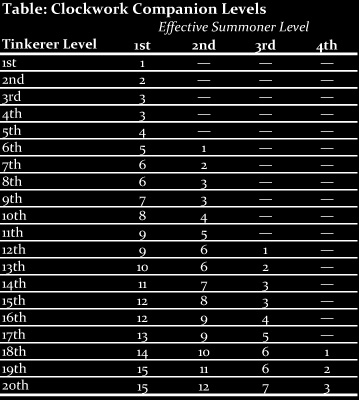The Tinkerer
Rogue is a class with a bit of an identity crisis, in that it needs to represent a lot of very different things to a variety of different people. A rogue is a debonair spy, well-versed in political intrigue. A rogue is also a street mugger who knows how to hit people exactly how it hurts. A rogue is also a slippery pickpocket who avoids confrontation whenever possible. Finally, the rogue is the trap man, who understands the inner workings of all kinds of mechanical devices and knows what makes them tick—and how to shut them off. This last aspect of the rogue gets less of the spotlight, but is, mechanically, one of the most identifying aspects of the rogue. So today’s archetype explores a version of the rogue that focuses more on machines and magic items, the tinkerer. Enjoy.
New Rogue Archetype
The Tinkerer
Kings of clockwork and masters of machinery, tinkerers are experts when it comes to all things man-made, including locks, traps, magic items, and even complex clockwork creatures. If you can build it, the tinkerer can take it apart, learn how it works, and put it back together again better than new.
Weapon and Armor Proficiency: Tinkerers are only proficient with simple weapons, and are not proficient with hand crossbows, rapiers, saps, shortbows, or short swords. They are still proficient with light armor, but not with shields.
Skills: At each level, a tinkerer gains 2 additional skill points, which must be spent on Craft skills.
Tinkerer (Ex): A tinkerer adds 1/2 her class level on all Disable Device checks and all Use Magic Device checks. A tinkerer can use Disable Device to disarm magic traps. A tinkerer counts as having the trapfinding class feature for the purposes of anything that requires it as a prerequisite.
This ability replaces the trapfinding class feature.
Clockwork Companion (Ex): A tinkerer begins play with a clockwork companion: a clockwork construct that she has cobbled together herself, which is loyal to her. Treat this as a summoner’s eidolon, with the following exceptions: the clockwork companion has the construct creature type and construct traits. It has no good saves, and does not gain skill points or feats, as it is mindless. Similarly, it does not have an Intelligence score. The clockwork companion also has the clockwork subtype, and the associated traits (winding, vulnerable to electricity, swift reactions, and difficult to create). Additionally, the clockwork companion has 3 fewer evolution points than an eidolon belonging to a summoner of the same level would have (this gives the clockwork companion 0 evolution points at 1st level).
The clockwork companion increases in power as the tinkerer increases in level, as indicated on the table below. Additionally, at 6th, 12th, and 18th levels, the tinkerer gains an additional clockwork companion, though she treats her effective summoner level as 5 lower for each of these than for the previous clockwork companion. This is also summarized on the table below.

Unlike an eidolon, a clockwork companion cannot be summoned or dismissed. However, a tinkerer can repair her clockwork companion via mundane means. Doing so takes 10 minutes, and the expenditure of 1d6 x 10 gp in raw materials. The tinkerer must make a Disable Device check as part of doing so, and the clockwork companion heals a number of hit points equal to the result of the check. A clockwork companion reduced to less than 0 hit points isn’t destroyed, merely rendered inert, and the tinkerer can repair it back to working condition, given enough time and resources. A clockwork companion that is reduced to -50 or fewer hit points is completely destroyed. Whenever a clockwork companion is completely destroyed or otherwise lost, the tinkerer can create a replacement. Doing so requires the expenditure of 100 gp per effective summoner level for the clockwork companion in question (rounded up), and takes 8 hours of work per five effective summoner levels.
This ability replaces the sneak attack class feature.
Master Craftsman (Ex): By 6th level, a tinkerer is so adept at tampering with magical items that she can easily recreate them. She gains the Master Craftsman feat as a bonus feat, even if she does not meet the prerequisites. Additionally, she can also use ranks in the chosen skill to qualify for the Craft Construct, Craft Rod, and Forge Ring feats, and can substitute her chosen skill for the caster level when creating magic items with those feats, as well.
This ability replaces the rogue talent gained at 6th level.
Accelerated Crafting (Ex): By 12th level, a tinkerer is so skilled at making magical items that she can do so in a fraction of the normal time. When creating a magic item, a tinkerer needs to spend only 1 hour per 1,000 gp in the item’s base price, instead of the usual 8 hours per 1,000 gp in the item’s base price.
This ability replaces the rogue talent gained at 12th level.
Jury Rig (Ex): At 20th level, a tinkerer can repair one of her clockwork companions as a full-round action that provokes attacks of opportunity, and doing so does not require the expenditure of any resources.
This ability replaces the master strike class feature.


